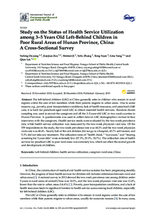Abstract: The left-behind children (LBC) in China generally refer to children who remain in rural regions under the care of kin members while their parents migrate to urban areas. Due to some reasons, e.g., poverty, poor transportation conditions, lack of health resources, and preschool child care, it is hard for preschool-aged rural LBC to obtain essential health services. Random cluster sampling was used to recruit the caregivers and all the 3–5-year-old LBC in two rural counties in Hunan Province. A questionnaire was used to collect data on LBC demographics via face-to-face interviews with the caregivers. Health service needs were evaluated by the two-week prevalence rate, while health service utilization was measured by the two-week physician visit rate. Of the 559 respondents in the study, the two-week prevalence rate was 44.2% and the two-week physician visits rate was 48.6%. Nearly half of the sick children did not go to a hospital, 45.7% self-treated, and 5.3% did not take any treatment. The utilization rates of “health check,” “eye exam,” and “hearing screening for 3-year-olds” were extremely low (57.3%, 29.3%, 18.7%). The utilization rate of health services for preschool LBC in poor rural areas was extremely low, which can affect the normal growth and development of children.

